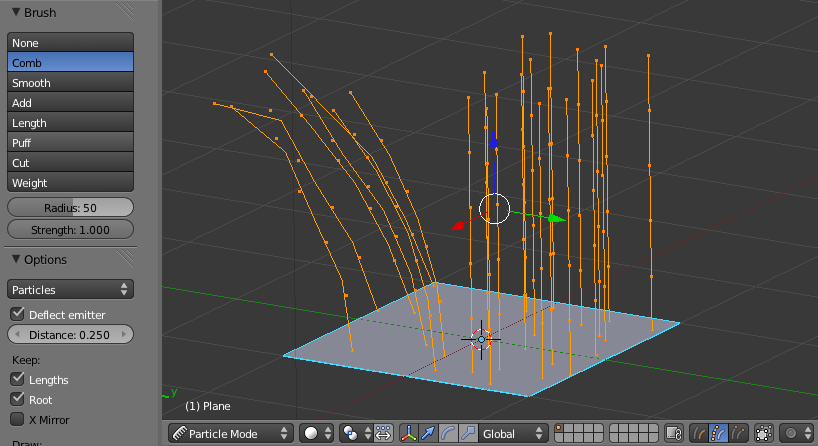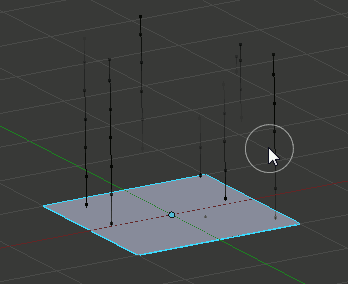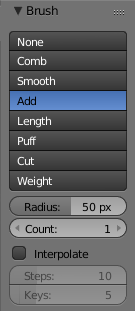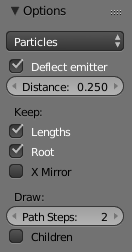Doc:2.6/Manual/Physics/Particles/Mode
Particle Edit mode
Using Particle Edit mode you can edit the key-points (key-frames) and paths of Baked Hair, Particle, Cloth, and Soft Body simulations. (You can also edit and style hair before baking).
Since working in particle mode is pretty easy and very similar to working with vertices in the 3D window, we will show how to set up a particle system and then give a reference of the various functions.
Ways to use Particle Edit mode
| Only Frames Baked to Memory are Editable! | |
| If you cannot edit the particles, check that you are not baking to a Disk Cache. |
Setup for Hair Particles
- Create a Hair particle system - With your object selected, click the Particle System icon in the Properties panel. Create a new particle system by clicking the Plus.
- Give it an initial velocity in the Normal direction (first check the Advanced box, then modify the Velocity sub-panel), or adjust the Hair Length.
- Create a simulation - Place the camera at a good position ( » View » Cameras » Active Camera ... or 0 NumPad). Check the Hair Dynamics box. Select » Render » Render OpenGL Animation in Info menu.
Setup for Particle, Cloth, and Soft Body Simulations
- Use Emitter particles, or a cloth/soft-body simulation
- Create a simulation - set up objects and or emitters, set your time range (use a small range if you are just starting out and experimenting), set up the simulation how you want it, using Alt+a to preview it.
Bake the Simulation
- Once you are happy with the general simulation, bake the simulation from Object mode. The simulation must be baked to enable editing. (remember to bake to memory, a disk cache will not be editable in Particle Edit mode)
Edit the Simulation
- Switch to Particle Edit from the Inteaction mode dropdown menu in the header of the 3D View to edit the particle's paths/key-frames. You may need to press T from within the 3D viewport to see the Particle Edit panels on Tool Shelf. Move to the frame you want to edit and use the various Particle Edit tools to edit your simulation. Work slowly, previewing your changes with Alt+a, and save often so that you can go back to the previous version should something happen, or that you do not like the latest changes you have made.
To be able to clearly see what you are working on:
- Turn on the Particle Edit Properties (PEP) panel with N.
- Select Point select mode in the header of the 3D window. This will display key points along the particle path.
| Brush Size | |
| Press F to resize the brush while working |
Using Particle Edit mode
Selecting Points
- Single: RMB
 .
. - All: A.
- Linked: Move the mouse over a keypoint and press L.
- Border select: B.
- First/last: W → Select First/Select Last.
You may also use the Select Menu.
| Selections | |
| Selections are extremely useful for modifying only the particles that you want. Hover over a particle path and press L to link-select it, hover over the next and press L to add that path to the selection. To remove a path, hold shift and press L. To Deselect all press A. The method to select individual points is the same as in Edit mode. click to select, shift+click to add/remove a point from the selection |
| Beware of Undo! | |
| Using Undo in Particle Edit mode can have strange results. Remember to save often! |
Moving keypoints or particles
- To move selected keypoints press G, or use one of the various other methods to grab vertices.
- To move a particle root you have to turn off Keep Root in the Tool Bar.
- You can do many of the things like with vertices, including scaling, rotating and removing (complete particles or single keys).
- You may not duplicate or extrude keys or particles, but you can subdivide particles which adds new keypoints (W → Subdivide/2 NumPad).
- Alternatively you can rekey a particle (W → Rekey/1 NumPad) and choose the number of keys.
How smoothly the hair and particle paths are displayed depends on the Path Steps setting in the Tool Bar. Low settings produce blocky interpolation between points, while high settings produce a smooth curve.
Mirroring particles
- If you want to create an X-Axis symmetrical haircut you have to do following steps:
- Select one of a particle path keypoint.
- Mirror the particle with Particle → Mirror W → Specials → Mirror menus.
- Turn on X Mirror in the Options section on the Tool Shelf for mirrored editing.
It may happen that after mirroring two particles occupy nearly the same place. Since this would be a waste of memory and rendertime, you can Remove doubles either from the Specials (W) or the Particle menu.
Hiding/Unhiding
Hiding and unhiding of particles works similar as with vertices in the 3D window. Select one or more keypoints of the particle you want to hide and press H. The particle in fact doesn’t vanish, only the key points.
Hidden particles (i.e. particles whose keypoints are hidden) don’t react on the various brushes. But:
If you use Mirror Editing even particles with hidden keypoints may be moved, if their mirrored counterpart is moved.
To un-hide all hidden particles press Alt+H.
Select Modes
- Path
- No keypoints are visible, you can select/deselect only all particles.
- Point
- You see all of the keypoints.
- Tip
- You can see and edit (including the brushes) only the tip of the particles, i.e. the last keypoint.
Brush
With the buttons you can select the type of Brush you want to use. Below the brush types, their settings appear:
- Common Brush Options
-
- Radius
- Set the radius if the brush.
- Strength
- Set the strength of the brush effect (not for Add brush).
- Brush Types and their options
- None
- Disables any brush, just edit the keypoints as “normal” vertices.
- Comb
- Moves the keypoints (similar to “proportional editing”).
- Smooth
- Parallels visually adjacent segments.
- Add
- Adds new hair particles.
- Count
- The number of new particles per step.
- Interpolate
- Interpolate the shape of new hairs from existing ones.
- Steps
- Amount of brush steps
- Keys
- How many keys to make new particles with.
- Length
- Scales the hair segments.
- Grow
- Brush Length mode of making the hair longer.
- Shrink
- Brush Length mode of making the hair shorter.
- Puff
- Make the hair stand up or lay down with rotating the hair around it’s first keypoint (root)
- Puff Volume
- Apply puff to unselected end-points (helps maintain hair volume when puffing root).
- Add
- Brush Length mode of making the hair stand up.
- Sub
- Brush Length mode of making the hair lay down.
- Cut
- Cuts hair with scaling the segments until the last keypoint reaches the brush.
- Weight
- This is especially useful for softbody animations, because the weight defines the softbody Goal. A keypoint with a weight of 1 won’t move at all, a keypoint with a weight of 0 subjects fully to softbody animation. This value is scaled by the GMin-GMax range of softbody goals.
Options
- Deflect Emitter
- Keep paths from intersecting the emitter.
- Distance
- Distance to keep particles away from the emitter.
- Keep
-
- Lengths
- Keep the length of the segments between the keypoints when combing or smoothing the hair. This is done by moving all the other keypoints.
- Root
- Keep first key unmodified, so you can’t transplant hair.
- X Mirror
- Enable mirror editing across the local x axis.
- Correct (only for emitter particles)
-
- Velocity
- Calculate point velocity automatically.
- Draw
-
- Path Steps
- Drawing steps, sets the smoothness of the drawn path.
- Children
- Draws the children of the particles too. This allows to fine tune the particles and see their effects on the result, but it may slow down your system if you have many children.
- Particles (only for emitter particles)
- Draw actual particles.
- Fade Time (only for emitter particles)
- Fade paths and keys further away from current time.
- Frames (only for emitter particles)
- How many frames to fade.



